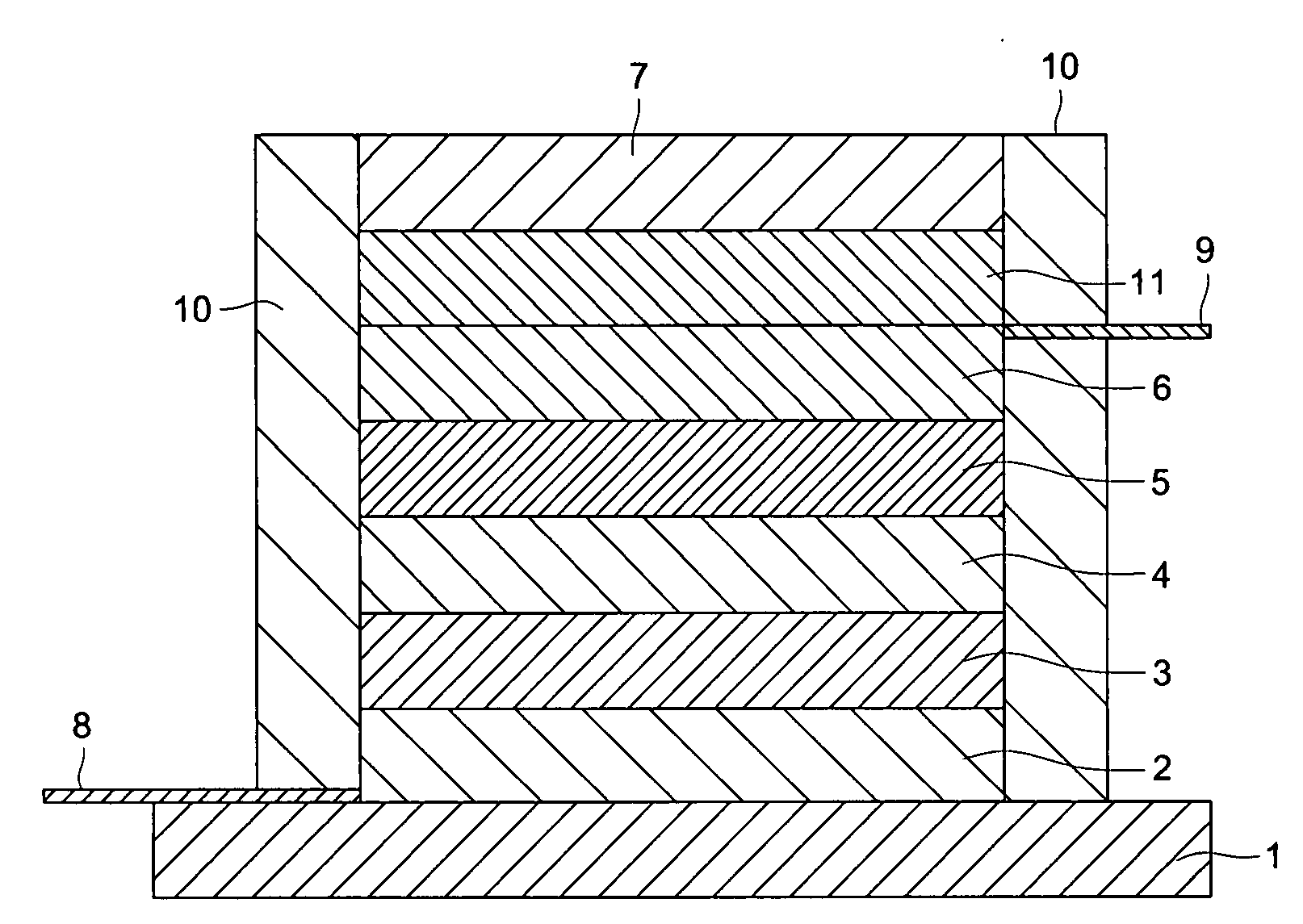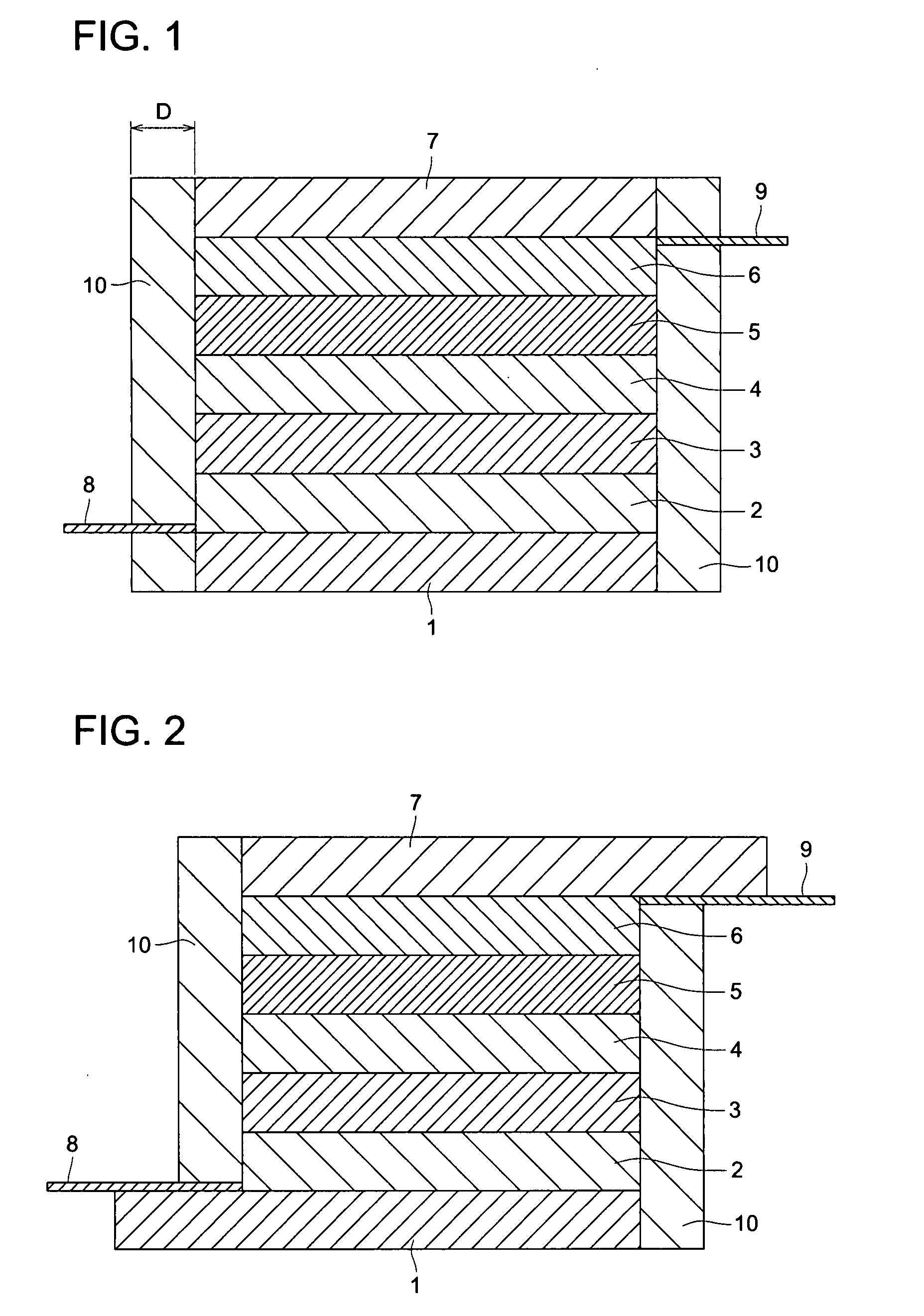Organic Electroluminescent Element, Production Method of the Same, Display Device, and Lighting Device
- Summary
- Abstract
- Description
- Claims
- Application Information
AI Technical Summary
Benefits of technology
Problems solved by technology
Method used
Image
Examples
examples
Preparation of Organic EL Element 1
[0286]Full-color Organic EL Element 1 composed of a cathode substrate / cathode / electron transporting layer / light emitting layer / positive hole transporting layer / anode / anode substrate was prepared as described below.
(A) Preparation of Cathode Laminated Body 1 (Anode Substrate / Anode / Electron Transporting Layer)
[0287]Both sides of a sheet of Al foil (at a thickness of 30 μm) was laminated with a 50 μm thick polyimide sheet (UPILEX 50S, produced by Ube Industries, Ltd.), and the resulting foil was cut to 35 mm×40 mm, whereby a cathode substrate was prepared.
[0288]The above cathode substrate was placed in a cleaning vessel. After cleaning it via i-propyl alcohol (IPA), it was subjected to oxygen plasma treatment. Subsequently, a mask (a mask arranged with stripes of a line width of 300 μm and an interval of 30 μm, as shown in FIG. 12) was arranged, and Al was vapor-deposited at a reduced pressure of about 0.1 mPa, whereby a stripe-structured cathode of a...
example 2
[0304]As described below, full-color Organic EL Element 2 was prepared, which was composed of a cathode substrate / cathode / electron transporting layer / light emitting layer / positive hole transporting layer / anode / anode substrate.
(A) Preparation of Cathode Laminated Body 2 (Cathode Substrate / Cathode / Electron Transporting Layer)
[0305]Both sides of an Al foil (at a thickness of 30 μm) was laminated with a 50 μm thick polyimide sheet (UPILEX 50S, produced by Ube Industries, Ltd.), and the resulting foil was cut to 35 mm×40 mm, whereby a cathode substrate was prepared.
[0306]The above cathode substrate was placed in a cleaning vessel. After cleaning it via i-propyl alcohol (IPA), an oxygen plasma treatment was applied. Subsequently, a mask (a mask arranged with stripes of a line width of 300 μm and an interval of 30 μm, shown in FIG. 12) for deposition, which was subjected to patterning, was arranged, and Al was vapor-deposited at a reduced pressure of about 0.1 mPa, whereby a stripe-structu...
example 3
Preparation of Organic EL Element 3
[0323]As described below, full-color Organic EL Element 3 was prepared, which was composed of a cathode substrate / cathode / electron transporting layer / light emitting layer / positive hole transporting layer / anode / anode substrate.
(A) Preparation of Cathode Laminated Body 3 (Cathode Substrate / Cathode / Electron Transporting Layer)
[0324]Both sides of an Al foil (at a thickness of 30 μm) was laminated with a 50 μm thick polyimide sheet (UPILEX 50S, produced by Ube Industries, Ltd.), and the resulting foil was cut to 35 mm×40 mm, whereby a cathode substrate was prepared.
[0325]The above cathode substrate was placed in a cleaning vessel. After cleaning it with i-propyl alcohol (IPA), an oxygen plasma treatment was applied. Subsequently, a mask (a mask arranged with stripes of a line width of 300 μm and an interval of 30 μm, shown in FIG. 12) for deposition, which was subjected to patterning, was arranged, and Al was vapor-deposited at a reduced pressure of abo...
PUM
| Property | Measurement | Unit |
|---|---|---|
| Percent by mass | aaaaa | aaaaa |
| Temperature | aaaaa | aaaaa |
| Thickness | aaaaa | aaaaa |
Abstract
Description
Claims
Application Information
 Login to View More
Login to View More - R&D
- Intellectual Property
- Life Sciences
- Materials
- Tech Scout
- Unparalleled Data Quality
- Higher Quality Content
- 60% Fewer Hallucinations
Browse by: Latest US Patents, China's latest patents, Technical Efficacy Thesaurus, Application Domain, Technology Topic, Popular Technical Reports.
© 2025 PatSnap. All rights reserved.Legal|Privacy policy|Modern Slavery Act Transparency Statement|Sitemap|About US| Contact US: help@patsnap.com



